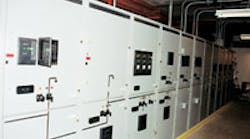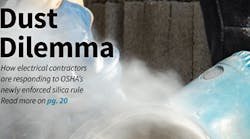Thanks to ongoing innovations in technology, electrical engineers' approach to motor protection has changed over the years. The traditional strategy to large AC motor protection (e.g., over 500 hp), used since the early 1900s, has been to use electromechanical relays that responded to motor current, voltage, and temperature so as to provide alarms and/or trip the motor offline. In this arrangement, the starter equipment is usually combined with the motor protection (typical panel is shown in the Photo). A new method, developed in the mid-1990s, is to use a microprocessor-based motor management relay, which responds to the same signal in a more intelligent manner.
Approach to motor protection
The selection of an AC motor protection system depends on the required reliability of the application and the cost of the protection system relative to the cost of the motor and its cost to repair. Relatively small fractional and integral-horsepower motors are protected by thermal overcurrent elements, which are built into the contactor-type motor starters. These starters provide protection in one of three ways: 1) time versus overcurrent; 2) loss-of-phase (i.e., voltage); 3) no restart or delayed restart on loss of voltage. Instead of being provided by a more costly protection system, reliability is provided by the relative ease of simply replacing motors that have failed.
Large motors, from 500 hp to 10,000 hp and higher, which are too costly to regularly replace, are protected by monitoring practically all-measurable parameters (e.g., stator current, terminal voltage, winding and bearing temperatures, ground fault current, vibration, and starting history). Control relays are used in logic patterns to generate alarm and tripping signals based on preset levels for each independent parameter.
However, a new concept in motor protection reflects the computer age, incorporating fault diagnostics, power metering, and RTU functions in one microprocessor-based relay package. Several advantages associated with this technology include: 1) the same relay package is used for a range of motor ratings; 2) the thermal model of the motor provides accurate overload monitoring; and 3) the relay is programmable on its front panel through an RS232 port that can also serve for firmware upgrade and interactive load control. Moreover, the relay can record events for diagnostic purposes.
The signals from the motor and its power equipment are delivered to the relay by current and voltage transformers, resistance temperature detectors (RTDs), tachometers, contacts on switchgear, and miscellaneous other devices. What this means is that the engineer can now select a particular relay with the necessary features for the particular application at hand — and do so in a cost-effective manner.
The functions of the most feature-rich electronic relays available today include the following:
Thermal model: The primary protective function of the relay is its thermal model, which contains the following five elements: overload curve, overload pickup, unbalance biasing of the motor current while the motor is running, motor cooling time constants, and biasing of the thermal model.
Standard overload curve: Motor heating in the stator and rotor during stall, acceleration, and running conditions is accounted for by the motor overload curve. If the motor starting times are in line with the safe stall times, one of the relay's 15 standard common shape curves is usually selected.
Custom overload curve: If the characteristics of the starting thermal damage curve and the running thermal damage curve are far apart, entering 30 pre-determined current levels would form the custom overload curve.
Voltage-dependent overload curve: If the motor application consists of driving a high inertia load, where the motor acceleration time exceeds the safe stall time defined by the motor manufacturer, then a voltage dependent overload curve needs to be developed.
Relay protective functions: The functions within the relay are shown in the Table on page 24, using standard ANSI definitions of relay functions. These functions are briefly explained in the next two sections and are known as motor starting and current elements functions.
Motor starting elements
To understand motor protection, you first must be familiar with the following functions.
Jogging block: This feature is used to prevent jogging the motor by performing multiple rapid start and stop operations. It includes starts per hour and time between starts. The start-per-hour feature prevents exceeding the preset number of motor starts per hour, while the time between starts only permits motor restarting based on a user programmed value.
Start inhibit: If the relay thermal capacity is insufficient for a motor to start, the start inhibit feature prevents starting of the motor. When the motor cools down and the level of thermal capacity falls to 100% capacity minus the learned starting capacity, a start is then permitted.
Restart block: The restart block feature is truly a timer. It may be used for certain process applications to preserve a certain amount of time between stopping and restarting the motor again (e.g., motor driving a very high-inertia load, or a motor is on a down-hole pump).
Current elements
Like motor starting elements, understanding how current elements work together is also essential.
Short circuit: When the current magnitude at any of the three phases exceeds the pickup level times the phase CT primary for the programmed time period of intentional pickup delay, a trip will occur.
Overload alarm: An alarm will occur if the equivalent motor heating current during motor starting exceeds the overload pickup level.
Mechanical jam: The mechanical jam feature provides motor protection for overload conditions and limits damages to the driven mechanical equipment. Once the current magnitude on any of the three phases exceeds the pickup level times the motor full load amps (FLAs) for the programmed time period of mechanical jam delay, a trip will occur.
Undercurrent: If the current magnitude at any of the three phases falls below the pickup level times the motor FLA for the programmed time period of undercurrent delay, a trip or alarm will occur.
Current unbalance: A 1% voltage unbalance translates into 6% current unbalance. When the motor operating load is greater than its full rated load, the relay calculates the ratio of the negative sequence to positive sequence currents, and a trip or alarm will occur when the unbalance magnitude exceeds the current unbalance pickup setting.
Ground fault: The relay has main and backup ground fault protection features. A trip or alarm will take place when the ground fault current exceeds the setting of the pickup level times the ground CT primary. If the ground fault trip backup feature is activated, a second trip to an assigned upstream breaker trip relay will occur, if the ground current persists longer than the programmed ground fault trip backup delay.
Phase differential: The phase differential feature consists of three instantaneous elements for phase differential protection. A trip will occur when the magnitude of one of the three-phase differential currents exceeds the pickup level times the differential CT primary for the programmed time period of differential delay.
One significant function of this type of relay is the ability to trace in memory the thermal capacity of the motor to absorb heat as measured by the RTDs in the windings. The available thermal capacity at any time determines overload time, ability to restart, and ability to start high-inertia loads.
Bottom line benefits
The new concept of a microprocessor-based motor protection relay produces the following advantages for the end-user:
-
Same relay for all ratings of motors.
-
Compact unit with all relay functions in one small form package.
-
Settings on front panel or by offline terminals.
-
Full power parameter monitoring and metering features.
-
Multiple communication ports for relay setting, load control, and monitoring.
-
Diagnostic features including event recording and oscillography.
-
Overload protection based on thermal model of the motor.
Kusko is vice president of Exponent Failure Analysis Associates in Natick, Mass. Ayoub is a lead power system engineer with GE Energy, Hanover, Md.




